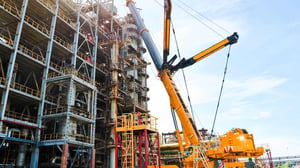Constructing Change: LCA's Impact on Global Warming
Is it possible to reduce the Global Warming Potential in building projects through Life Cycle Assessment? The answer could seem obvious, and you might even say LCA is the ideal method to evaluate the environmental footprint of construction projects, facilitating practices that can significantly reduce the GWP.
We are facing escalating concerns over climate change, which is why the construction industry is increasingly focusing on becoming greener, particularly by reducing the Global Warming Potential of buildings. This is achievable through an approach called Life Cycle Assessment, which provides a comprehensive analysis of the environmental impact of the industry by documenting the impact of materials and processes throughout the lifecycle of a building.
Life Cycle Assessment as a Critical Tool in Construction
As a critical tool in the construction industry, Life Cycle Assessment can help reduce Global Warming Potential by providing a comprehensive analysis on the environmental impact of building projects. This approach covers all steps from inception to the completion of a project, including material production, construction, usage, and eventual demolition and recycling. This lets stakeholders make more informed and sustainable decisions by providing a holistic view of the environmental consequences of any building project. The ability to evaluate the environmental footprint effectively, however, depends on the availability and quality of the data used – how accurate and extensive it is.

STAY IN THE KNOW!
Sign up for our newsletter and receive timely insights about LCA and sustainable construction.
In the construction industry there are a multitude of materials, methods, and scales, posing many challenges to standardizing LCA processes. Each building project is unique, involving several stakeholders, including architects, engineers and contractors, and each one adds layers of complexity in trying to achieve uniform environmental assessments. Adding to the mix the evolving nature of building materials and various regulations, makes maintaining an up-to-date and comprehensive database for LCA quite a challenge. Data inaccuracy can affect the LCA outcomes and thereby decision-makers who depend on their guidance for sustainable practices. Innovative tools and methodologies that can help standardize LCA-processes and improve data quality will ensure more reliable and effective environmental assessments in construction.
Understanding Global Warming Potential
Wikipedia defines Global Warming Potential (GWP) as an "index measuring the radiative forcing following an emission of a unit mass of a given substance, accumulated over a chosen time horizon, relative to that of the reference substance, carbon dioxide (CO2). The GWP thus represents the combined effect of the differing times these substances remain in the atmosphere and their effectiveness in causing radiative forcing."
In other words, Global Warming Potential is a way to measure and compare the relative impact different greenhouse gases have on global warming. It is a measure of how much heat a given greenhouse gas traps in the atmosphere over a certain period, typically 100 years, as compared to the same for carbon dioxide (CO2). CO2 is the yardstick and reference for all other gases, with a GWP of 1. All greenhouse gases are translated into carbon dioxide equivalents measured in kilos (kg) to create comparable units. Greenhouse gases such as methane (CH4) and nitrous oxide (N2O) therefore have higher GWPs because they are more potent in trapping heat than CO2 and contribute significantly more to global warming.
Life Cycle Assessment offers a detailed assessment of environmental impacts, in particular the Global Warming Potential, and thereby enables informed decision-making that prioritizes sustainability. Using LCA in the building industry is therefore a significant step towards reducing the GWP in construction.
Learn more: Challenges, Innovations, and Future Directions in Sustainable Construction
Measuring the Global Warming Potential in LCA
Building projects that utilize Life Cycle Assessment lets you ascertain the Global Warming Potential of the materials and processes involved, measured in comparable quantities. LCA can provide a detailed analysis of the environmental impact of all stages in the building process, from raw material extraction, manufacturing, transportation, and construction, to its use, maintenance, and ultimately disposal or recycling. When assessing the GWP of a project, Life Cycle Assessment is used to consider the emissions of all relevant greenhouse gases, measured in their CO2 equivalents.
This approach gives a holistic understanding of the environmental footprint of the building project, especially how it contributes to global warming. Reducing the Global Warming Potential of building projects is an important step in mitigating the impact on climate change. Three strategies can be especially impactful to this end:
Low-carbon materials
In a building project, the choice of building materials has one of the greatest impacts on the GWP. To maintain a low GWP-score, materials that have low embodied carbon should be selected, as they have lower greenhouse gas emissions throughout their life cycles. Using sustainable timber rather than steel or concrete can significantly reduce the GWP, since timber binds carbon dioxide in its growth phase.
Energy Efficiency
By implementing energy-efficient designs and systems, a building project can achieve a reduced operational carbon footprint of the constructed building. This could involve using energy-efficient appliances, optimizing and utilizing natural light, and incorporating renewable energy sources, such as solar panels or district heating.
Waste Reduction and Management
Implementing measures for efficient waste management during the building construction and using recycled materials will help reduce the Global Warming Potential of the building. By reducing waste production and reusing materials, the need for new raw materials with their associated emissions is minimized.

DOWNLOAD OUR LCA WHITEPAPER!
Learn more about LCA in our whitepaper available for free.The Role of Environmental Product Declarations in Reducing the GWP
Integrating Environmental Product Declarations (EPD) in the LCA methodology increases its effectiveness by offering detailed information on construction materials. EPD provides transparent and verified information about the lifecycle impact of products on the environment, including their Global Warming Potential. EDP promotes transparency in the construction industry and is an important contribution towards more sustainable and low-GWP practices.
EDP is therefore central in achieving low-GWP building projects. By evaluating and considering EPD the project stakeholders – architects, builders, and clients – can make more informed and better decisions, selecting materials and methods that directly impacts and reduces the GWP of their project. In addition to improving the sustainability in construction practices, the process can also help guide the industry towards more environmentally responsible choices, and significantly reduce the impact on global warming.
Essential strategies in achieving this include the adoption of low-carbon materials, energy-efficient designs, waste reduction practices and using EDP. These practices are not just environmentally sound choices but becoming gold standards in the industry to collectively reduce global warming. The future of sustainable construction depends on our ability to understand, measure, and reduce the GWP of building projects, utilizing practices and methods such as LCA and EPD.



